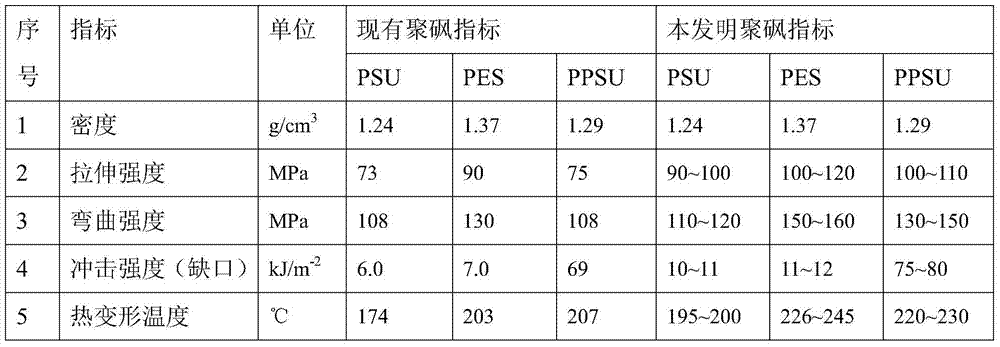A kind of industrial synthesis method of branched high-strength polysulfone resin
A technology of polysulfone resin and synthesis method, which is applied in the field of industrial high-pressure synthesis of high-strength polysulfone resin, can solve the problems of inability to completely remove benzene-based water-separating agents, deep resin color, and low light transmittance, and achieve improved toughness, Improve productivity and break application limitations
- Summary
- Abstract
- Description
- Claims
- Application Information
AI Technical Summary
Problems solved by technology
Method used
Image
Examples
Embodiment 1
[0028] In a 300-liter stainless steel reaction kettle equipped with a nitrogen pipe, a condensing water separator and a high-efficiency stirrer, add 35.0kg of 4,4'-dichlorodiphenyl sulfone, 29.5kg of bisphenol A, and 14.0kg of sodium carbonate in sequence, and then add 100.00kg N,N'-dimethylacetamide. After pumping air to reduce the pressure inside the kettle to -0.09MPa, introduce nitrogen to raise the pressure inside the kettle to 0.01MPa, repeat this process five times to vacuumize and introduce nitrogen to replace the air in the kettle, and finally introduce nitrogen to reduce the pressure in the kettle to 0.01MPa. The pressure was raised to 2.0MPa. Heat to make the temperature in the kettle reach 170°C and form salt at constant temperature for 1 hour, then raise the temperature to 200°C for constant temperature polymerization for 3 hours, then add 288g of methyldichlorosilane to the system, increase the stirring speed to 70-90 rpm, and continue to keep constant temperatur...
Embodiment 2
[0032] Same as implementation case 1, except that the pressure inside the kettle is 3MPa, and 288g of methyldichlorosilane is replaced by 790g of phenoxy titanium trichloride, other conditions are the same.
[0033] The resulting high-strength polysulfone (PSU) resin MI=15.0g / 10min (343.0°C, 2.16kg), impact strength 10.9kJ / m -2 , thermal deformation: 195°C
Embodiment 3
[0035] In a 300-liter stainless steel reaction kettle equipped with a nitrogen pipe, a condensing water separator and a high-efficiency stirrer, 35.0kg of 4,4'-dichlorodiphenyl sulfone, 32.32kg of bisphenol S, 14.0kg of sodium carbonate were added in sequence, and then 100.00kg N,N'-dimethylformamide. After pumping air to reduce the pressure inside the kettle to -0.09MPa, introduce nitrogen to raise the pressure inside the kettle to 0.01MPa, repeat this process five times to vacuumize and introduce nitrogen to replace the air in the kettle, and finally introduce nitrogen to reduce the pressure in the kettle to 0.01MPa. The pressure was raised to 3.0MPa. Heat to make the temperature in the kettle reach 200°C to form salt at constant temperature for 1 hour, then raise the temperature to 240°C for constant temperature polymerization for 3 hours, then add 488g of ethoxy titanium trichloride to the system, increase the stirring speed to 70-90 rpm, Continue to keep the temperature ...
PUM
| Property | Measurement | Unit |
|---|---|---|
| impact strength | aaaaa | aaaaa |
| thermal deformation | aaaaa | aaaaa |
| impact strength | aaaaa | aaaaa |
Abstract
Description
Claims
Application Information
 Login to View More
Login to View More - R&D
- Intellectual Property
- Life Sciences
- Materials
- Tech Scout
- Unparalleled Data Quality
- Higher Quality Content
- 60% Fewer Hallucinations
Browse by: Latest US Patents, China's latest patents, Technical Efficacy Thesaurus, Application Domain, Technology Topic, Popular Technical Reports.
© 2025 PatSnap. All rights reserved.Legal|Privacy policy|Modern Slavery Act Transparency Statement|Sitemap|About US| Contact US: help@patsnap.com

